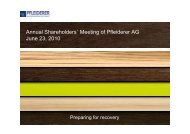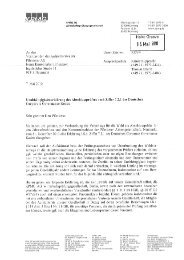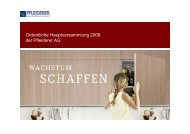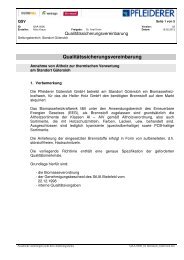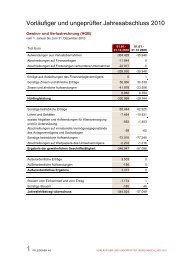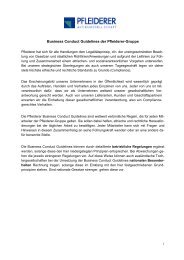1 PFLEIDERER AG NINE-MONTH FINANCIAL REPORT 2007
1 PFLEIDERER AG NINE-MONTH FINANCIAL REPORT 2007
1 PFLEIDERER AG NINE-MONTH FINANCIAL REPORT 2007
Create successful ePaper yourself
Turn your PDF publications into a flip-book with our unique Google optimized e-Paper software.
Revenue recognition<br />
Revenues are generated mainly from the supply of products and, to a minor extent, from services.<br />
These revenues are recognized net of VAT and sales reductions, such as bonuses, cash discounts,<br />
or rebates, at the date at which they are deemed by IFRSs to be realized. This is generally the case<br />
when persuasive evidence of an agreement exists, delivery has occurred, or services have been<br />
rendered, the price is fixed or clearly determinable, and actual payment can be reasonably assured.<br />
Revenues from construction contracts are considered to be realized once the total revenue, total<br />
costs, and stage of completion can be determined with sufficient reliability. No revenues were<br />
generated during the first nine months of the fiscal year that were accounted for using the percentage<br />
of completion method.<br />
Income taxes<br />
Income tax expense comprises both current income taxes payable and deferred taxes. Deferred<br />
taxes on items included in other comprehensive income are recognized directly in equity. Income<br />
taxes attributable to discontinued operations are reported as income taxes on discontinued<br />
operations.<br />
Deferred tax assets and liabilities are recognized for temporary differences between the carrying<br />
amounts of assets and liabilities in the consolidated balance sheet and their tax base, and for tax loss<br />
carryforwards whose utilization will probably result in tax benefits in future periods. The tax laws that<br />
have been enacted or substantively enacted as of the balance sheet date are used to measure<br />
deferred taxes. A tax rate of 28.3 percent (37.5 percent until the end of the second quarter of <strong>2007</strong>) is<br />
used to compute domestic deferred taxes. The local country-specific tax rates are used for foreign<br />
companies.<br />
Research and development costs<br />
Research costs are generally recognized as expenses when they are incurred. Exceptions are those<br />
development costs that meet the criteria defined in IAS 38, Intangible Assets, and are required to be<br />
capitalized. Capitalized development costs are amortized over their expected useful lives.<br />
Cash and cash equivalents<br />
Cash and cash equivalents comprise cash on hand and at banks, as well as sight deposits with<br />
banks with original maturities of up to three months.<br />
Receivables<br />
Receivables are recognized at fair value, i.e., at their principal amount less specific valuation<br />
allowances and write-downs (bonuses, cash discounts, and other sales reductions). Specific<br />
valuation allowances are recognized if receivables become entirely or partly uncollectible, or if it is<br />
probable that they will not be collectible, and the amount of the write-down can be determined<br />
sufficiently accurately. Adequate deductions are recognized directly on the assets side of the balance<br />
sheet for bonuses and cash discounts.<br />
Sales of receivables are accounted for within the Group in accordance with IAS 39, Financial<br />
Instruments: Recognition and Measurement. In accordance with this Standard, financial assets must<br />
be derecognized if the contractual rights to the cash flows from the financial asset expire or if the<br />
financial asset is transferred.<br />
27 <strong>PFLEIDERER</strong> <strong>AG</strong> <strong>NINE</strong>-<strong>MONTH</strong> <strong>FINANCIAL</strong> <strong>REPORT</strong> <strong>2007</strong>



